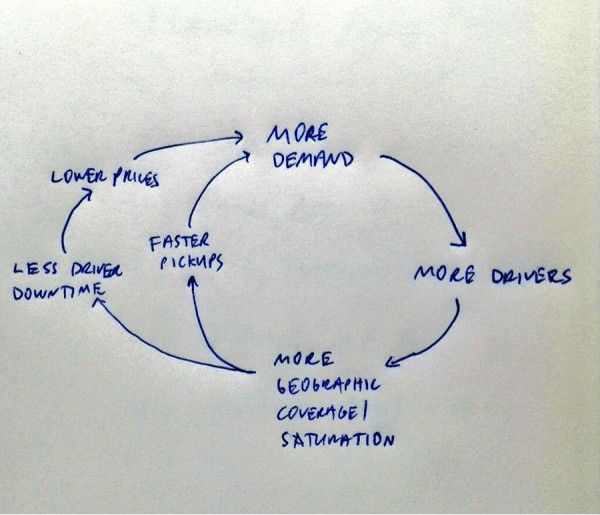Digital Transformation
Uber: The feedback loop disrupting transportation
When Uber was valued at tens of billions of dollars, there was significant criticism from valuation experts (Aswath Damodaran, no less) and an equally compelling response from one of Uber’s earliest investors, Bill Gurley. One of the best things that emerged from these discussions (in conjunction with a back-of-the-napkin sketch tweeted by David Sacks, founder of Yammer) was a much more nuanced discussion of the feedback loop that drives Uber’s network effect.

Uber is a classic two-sided marketplace where more cars on the network attract more travelers and vice versa. But as with any network effect, it isn’t simply the number of cars and travelers that attract each other but the levels of participation of both sides. A higher participation from drivers is useful only if it results in higher availability, and consequently, lower waiting time for passengers. Similarly, a higher participation from passengers is useful to drivers only when it means lower downtime and, potentially, the ability to charge higher prices, thanks to Uber’s much-maligned surge pricing. (Surge pricing increases rates as demand overtakes supply)
Uber’s feedback loop works in the following way:
More drivers equal shorter pickup times
More drivers available at any given point in time result in shorter pickup times as the probability of matching a request to a drive in the vicinity is that much higher. Shorter pickup times, in turn, lead to greater and wider usage.
Network effects don’t simply happen. They are most often the result of carefully building and fueling a feedback loop.
Feel Free to Share
Download
Download Our Insights Pack!
- Get more insights into how companies apply platform strategies
- Get early access to implementation criteria
- Get the latest on macro trends and practical frameworks
More usage leads to higher coverage
As more drivers fuel more usage, more usage, in turn, brings in more drivers on the road. Uber’s network is a city-level network and usually starts from the center of the city. Over time, as this feedback loop picks up, demand starts sparking up in the fringes and drivers start getting onto the platform and serving the fringes as well. Hence, greater usage increases saturation within the city, since the city has a finite limit. With greater saturation, the pickup times further fall, thereby attracting more demand, leading to a positive feedback.
Greater liquidity leads to better prices
As more demand and supply flood in, the waiting time for drivers falls. With lower waiting times as well as higher availability of drivers, the platform can offer better prices to travelers. This, in turn, brings in more travelers into the system and the virtuous feedback loop gets strengthened further.
Uber has a fairly nuanced feedback loop. As with the case of the data-driven feedback loop in peer lending, and the curation-driven feedback loop for many market-making platforms, it pays to understand the factors that contribute to a positive feedback loop. Paying close attention to these factors and architecting the conditions that encourage these factors strengthens the network effect over time.
Network effects don’t simply happen. They are most often the result of carefully building and fueling a feedback loop.
Image Credits: David Sacks
State of the Platform Revolution
The State of the Platform Revolution report covers the key themes in the platform economy in the aftermath of the Covid-19 pandemic.
This annual report, based on Sangeet’s international best-selling book Platform Revolution, highlights the key themes shaping the future of value creation and power structures in the platform economy.
Themes covered in this report have been presented at multiple Fortune 500 board meetings, C-level conclaves, international summits, and policy roundtables.
Subscribe to Our Newsletter













